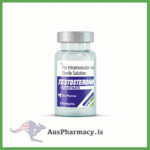Sci-Pharma Cialis 10 mg – Educational Study of Tadalafil and PDE5 Inhibition Mechanisms
Sci-Pharma Cialis (Tadalafil) 10 mg serves as an important educational compound in the study of pharmacodynamics, enzyme inhibition, and cardiovascular physiology.
Within academic and biomedical science, tadalafil demonstrates how selective enzyme inhibitors can regulate smooth muscle activity and influence blood flow mechanisms.
Students and researchers study Cialis to understand PDE5 inhibition, a critical concept in pharmacology that illustrates how biochemical signaling affects physiological function.
2. Chemical Structure and Composition
Tadalafil is a selective phosphodiesterase type 5 (PDE5) inhibitor belonging to the class of heterocyclic organic compounds.
-
Molecular Formula: C₂₂H₁₉N₃O₄
-
Molecular Weight: 389.4 g/mol
-
Chemical Class: Pyrazinoindole derivative
-
Mechanism of Action: PDE5 enzyme inhibition
Educational programs use tadalafil to teach how structural modifications in molecules influence selectivity, potency, and duration of pharmacological effect.
3. Mechanism of Action
The core educational concept behind tadalafil is PDE5 inhibition.
Phosphodiesterase type 5 breaks down cyclic guanosine monophosphate (cGMP) in smooth muscle tissue. Tadalafil inhibits this enzyme, allowing cGMP to accumulate, resulting in smooth muscle relaxation and vasodilation.
This process highlights key pharmacological principles:
-
Signal transduction through nitric oxide (NO) pathways
-
Enzyme inhibition and second-messenger amplification
-
Targeted vasodilation and tissue-specific selectivity
Students use this mechanism to explore the relationship between molecular biology, physiology, and therapeutic pharmacology.
4. Academic Significance in Pharmacology
In pharmacology education, Cialis is used to illustrate:
-
Enzyme kinetics and inhibition models
-
Receptor-effector coupling in smooth muscle cells
-
Dose-response relationships and saturation curves
-
Therapeutic target identification through enzyme selectivity
These lessons help future scientists understand how enzyme inhibitors are designed to achieve precision in pharmacological action.
5. Pharmacokinetics and Biotransformation
Tadalafil’s pharmacokinetic profile makes it a valuable teaching example for long-acting oral drugs.
-
Absorption: Rapid oral absorption, food has minimal effect
-
Distribution: High protein binding (~94%)
-
Metabolism: Hepatic via CYP3A4
-
Elimination half-life: ~17.5 hours
-
Excretion: Fecal and urinary routes
Through these data, students learn how metabolic pathways, enzyme systems, and structural chemistry influence duration of action.
6. Molecular Mechanisms and Enzyme Interaction
At the molecular level, tadalafil binds to the catalytic site of PDE5, preventing cGMP degradation.
This mechanism enhances smooth muscle relaxation, providing a model for understanding allosteric inhibition and enzyme–substrate competition.
Educational discussions focus on:
-
Structure–activity relationships (SAR)
-
Enzyme binding affinity and molecular docking
-
Secondary messenger signaling in vascular tissue
These topics help bridge organic chemistry, enzymology, and physiology.
7. Educational Laboratory Applications
In academic and laboratory research, Sci-Pharma Cialis 10 mg serves as a model compound for:
-
High-performance liquid chromatography (HPLC) quantification
-
Spectroscopic characterization (UV, IR, NMR)
-
In vitro enzyme inhibition assays
-
Molecular modeling simulations
These experiments help students develop analytical and research skills vital for pharmaceutical science.
8. Comparative Study in Pharmacology
Students often compare tadalafil with other PDE5 inhibitors such as sildenafil (Viagra) and vardenafil (Levitra) to understand:
-
Variations in molecular structure and receptor affinity
-
Differences in onset, duration, and selectivity
-
Pharmacokinetic versus pharmacodynamic properties
Such comparisons deepen understanding of drug optimization and clinical pharmacology.
9. Physiological Concepts and Educational Value
Cialis helps demonstrate key physiological principles, including:
-
The nitric oxide–cGMP signaling pathway
-
Mechanisms of vascular smooth muscle tone regulation
-
Concepts of blood pressure modulation and flow control
By studying these pathways, students connect biochemical reactions with organ-level responses, an essential part of modern biomedical education.
10. Research and Development Insights
From a research perspective, tadalafil is used as a model in:
-
Enzyme kinetics research
-
Computational pharmacology for drug design
-
Tissue receptor mapping studies
-
Pharmacogenetic analysis
These areas illustrate how laboratory findings translate into theoretical models of drug behavior.
11. Role in Pharmaceutical Education
Cialis exemplifies principles of drug discovery and medicinal chemistry, showing how molecular design affects potency, selectivity, and bioavailability.
Students can learn about the stages of drug development, from lead compound synthesis to structure refinement and clinical evaluation.
12. Ethical and Laboratory Safety Considerations
Educational handling of PDE5 inhibitors requires strict adherence to research ethics and laboratory regulations.
Academic use must occur under controlled conditions, ensuring that compounds are handled responsibly and solely for educational or analytical purposes.
13. Sci-Pharma’s Educational Commitment
Sci-Pharma supports academic institutions by providing research-grade reference materials that meet purity and analytical standards.
Through these compounds, students and educators can explore pharmacodynamics and medicinal chemistry in a safe and structured environment.
14. Conclusion
Sci-Pharma Cialis (Tadalafil) 10 mg serves as a powerful educational model for understanding enzyme inhibition, cardiovascular pharmacology, and molecular drug design.
By studying its structure, mechanism, and pharmacokinetic properties, students gain essential insights into how biochemical interactions drive physiological outcomes.
This academic exploration bridges chemistry, biology, and pharmacology—helping learners understand how molecular science translates into therapeutic innovation in modern medicine.








